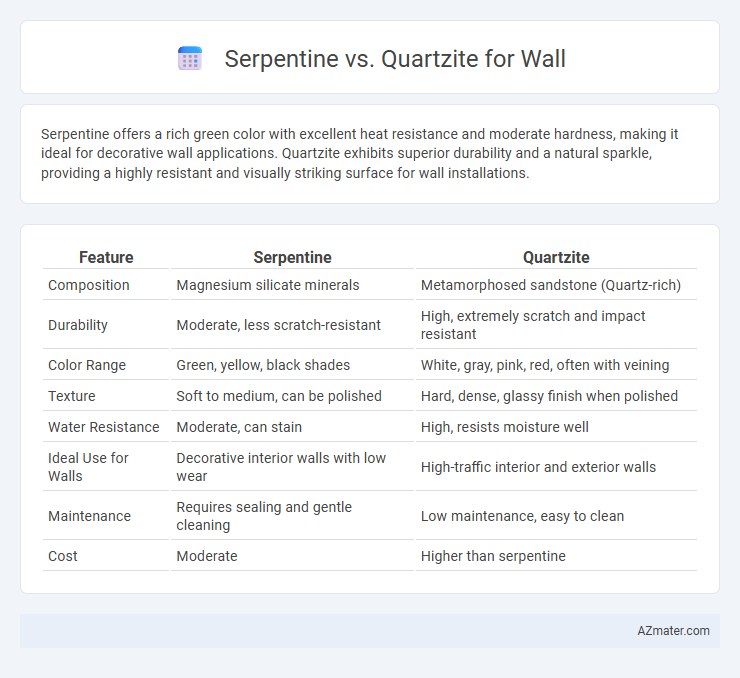Serpentine offers a rich green color with excellent heat resistance and moderate hardness, making it ideal for decorative wall applications. Quartzite exhibits superior durability and a natural sparkle, providing a highly resistant and visually striking surface for wall installations.
Table of Comparison
| Feature | Serpentine | Quartzite |
|---|---|---|
| Composition | Magnesium silicate minerals | Metamorphosed sandstone (Quartz-rich) |
| Durability | Moderate, less scratch-resistant | High, extremely scratch and impact resistant |
| Color Range | Green, yellow, black shades | White, gray, pink, red, often with veining |
| Texture | Soft to medium, can be polished | Hard, dense, glassy finish when polished |
| Water Resistance | Moderate, can stain | High, resists moisture well |
| Ideal Use for Walls | Decorative interior walls with low wear | High-traffic interior and exterior walls |
| Maintenance | Requires sealing and gentle cleaning | Low maintenance, easy to clean |
| Cost | Moderate | Higher than serpentine |
Introduction to Serpentine and Quartzite
Serpentine is a metamorphic rock characterized by its smooth, greenish texture and high magnesium content, commonly used for decorative wall cladding due to its unique aesthetic appeal and durability. Quartzite, formed from sandstone subjected to intense heat and pressure, is a hard, dense stone prized for its durability and resistance to weathering, making it ideal for both interior and exterior walls. Understanding the mineral composition and formation of serpentine and quartzite helps in selecting the appropriate stone for specific architectural and design requirements.
Geological Formation and Composition
Serpentine forms through the metamorphic alteration of ultramafic rocks, primarily composed of magnesium silicate minerals, resulting in a distinctive green color and smooth texture ideal for decorative walls. Quartzite originates from the metamorphism of pure quartz sandstone, characterized by its high quartz content and exceptional hardness, providing durable and abrasion-resistant wall surfaces. The contrasting mineral compositions and geological formation processes of serpentine and quartzite influence their color, texture, and suitability for various architectural applications.
Visual Appearance and Color Variations
Serpentine offers rich, deep green hues with swirling patterns that create a luxurious and dynamic visual appeal, making it popular for accent walls and decorative features. Quartzite features a broader color palette, ranging from whites and grays to subtle pinks and blues, with a granular texture that delivers a sophisticated, natural stone look. Both materials provide unique aesthetic qualities, with serpentine showcasing dramatic veining and quartzite emphasizing a more understated and versatile appearance.
Strength and Durability Comparison
Serpentine and quartzite differ significantly in strength and durability for wall applications, with quartzite being notably harder and more resistant to scratching and impact due to its high quartz content and Mohs hardness rating of 7. Serpentine, while visually appealing with its unique patterns, typically ranks lower in hardness around 3 to 6 and is more susceptible to weathering and chemical erosion. Quartzite's superior compressive strength and low porosity make it ideal for exterior and high-traffic walls where longevity and minimal maintenance are critical.
Water and Stain Resistance
Serpentine offers moderate water resistance but tends to be more porous, making it susceptible to staining and requiring regular sealing for wall applications. Quartzite exhibits superior water and stain resistance due to its dense, non-porous structure, making it more durable and low-maintenance for wet or high-traffic areas. Choosing quartzite ensures long-lasting protection against moisture damage and staining in wall installations.
Installation and Maintenance Considerations
Serpentine offers easier installation due to its softer composition, allowing for smoother cutting and shaping on walls, which reduces labor time and tool wear. Quartzite, while harder and more durable, demands specialized tools and skilled labor to prevent chipping during installation, increasing initial costs. Maintenance for serpentine involves regular sealing to protect against stains and moisture, whereas quartzite's dense structure requires less frequent sealing and resists weathering, making it a low-maintenance choice for long-term wall applications.
Cost Differences: Serpentine vs Quartzite
Serpentine is generally more affordable than quartzite due to its abundant availability and easier quarrying processes. Quartzite commands a higher price reflecting its superior hardness, durability, and resistance to heat and scratches, making it ideal for high-traffic wall applications. The cost difference often influences project budgets, with serpentine offering a budget-friendly alternative without significantly compromising aesthetic appeal.
Popular Applications in Wall Design
Serpentine and quartzite are both popular choices for wall design, valued for their durability and aesthetic appeal. Serpentine is often used in interior feature walls and accent panels due to its distinctive green hues and smooth texture, enhancing modern or rustic spaces. Quartzite's high hardness and resistance to weathering make it ideal for both interior and exterior cladding, including fireplaces and facade walls, providing a natural stone look with superior longevity.
Environmental Impact and Sustainability
Serpentine offers a lower environmental impact due to its widespread availability and lower energy-intensive processing compared to quartzite, which requires significant quarrying and high-temperature treatment. Quartzite's durability and longevity contribute to sustainability by reducing the need for frequent replacements, but its extraction often disrupts ecosystems and consumes more energy. Choosing serpentine for walls supports reduced carbon emissions and resource conservation, while quartzite provides long-term sustainability through enhanced material resilience.
Choosing the Right Stone for Your Walls
Quartzite offers superior hardness and resistance to scratches and heat, making it an excellent choice for durable wall surfaces in high-traffic or moisture-prone areas. Serpentine, known for its striking green hues and smooth texture, provides an aesthetic advantage but is softer and more susceptible to weathering and staining. Selecting quartzite ensures long-lasting structural integrity for walls, while serpentine suits decorative applications where elegance outweighs the need for extreme durability.

Infographic: Serpentine vs Quartzite for Wall
 azmater.com
azmater.com